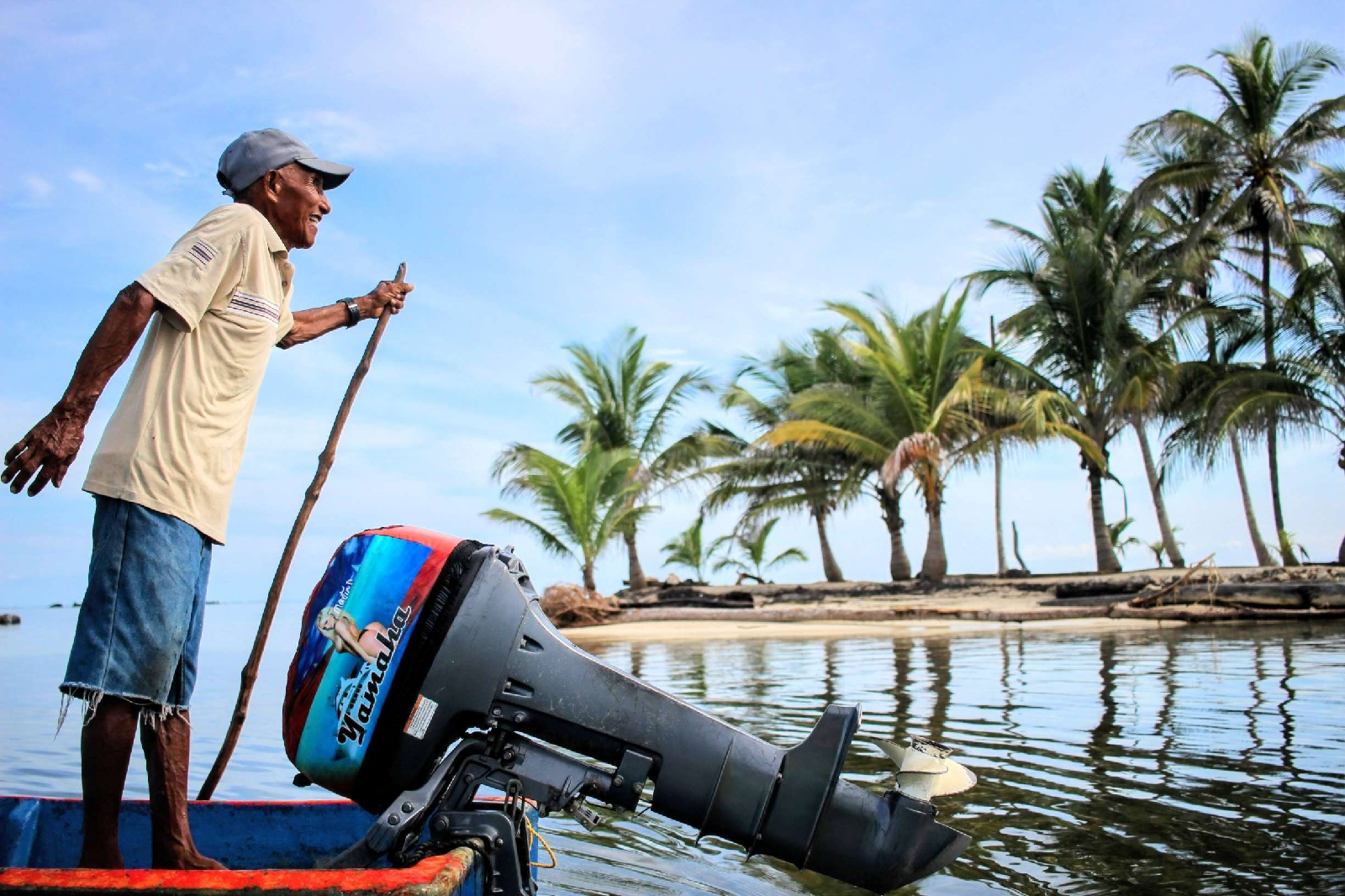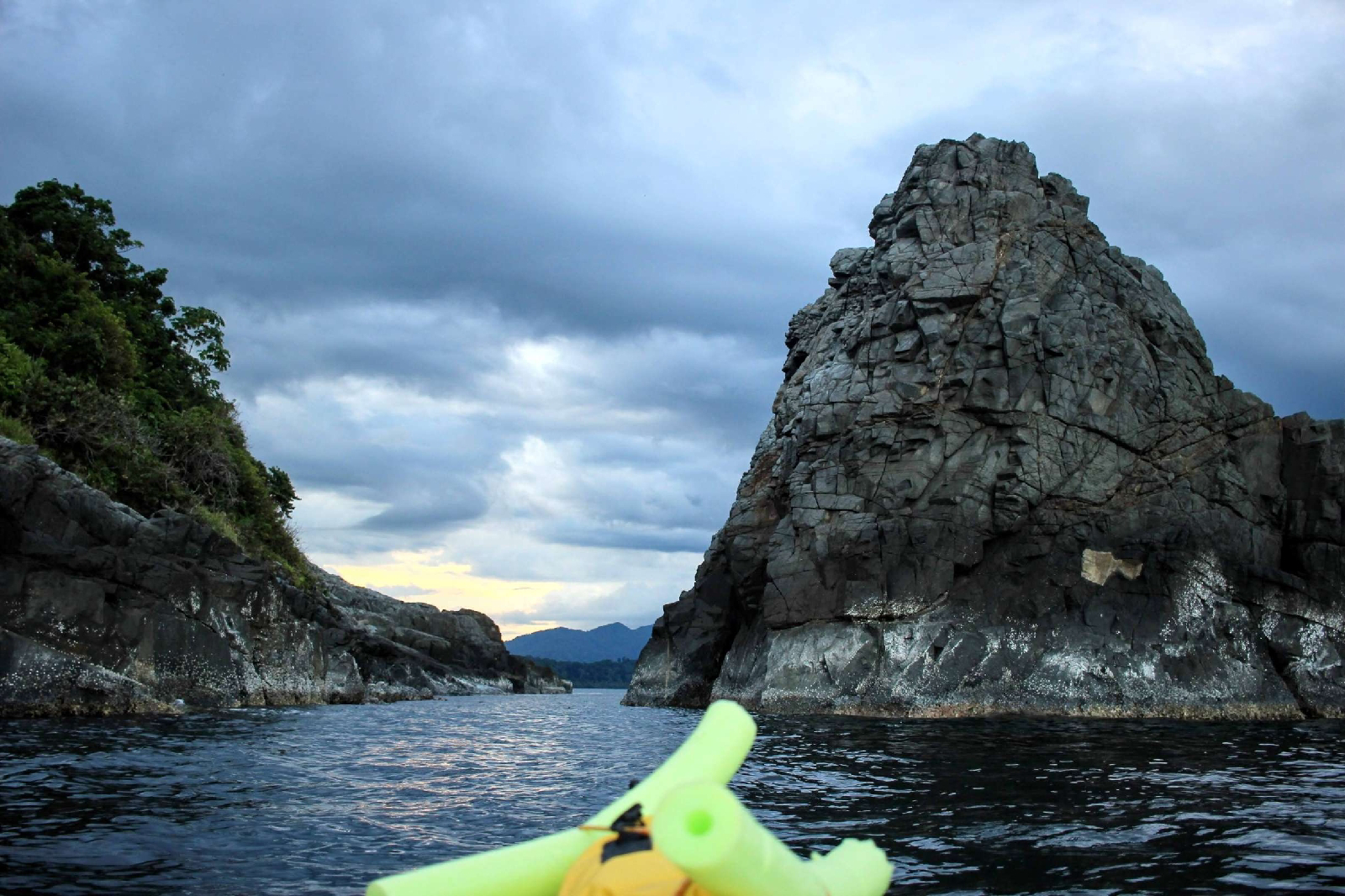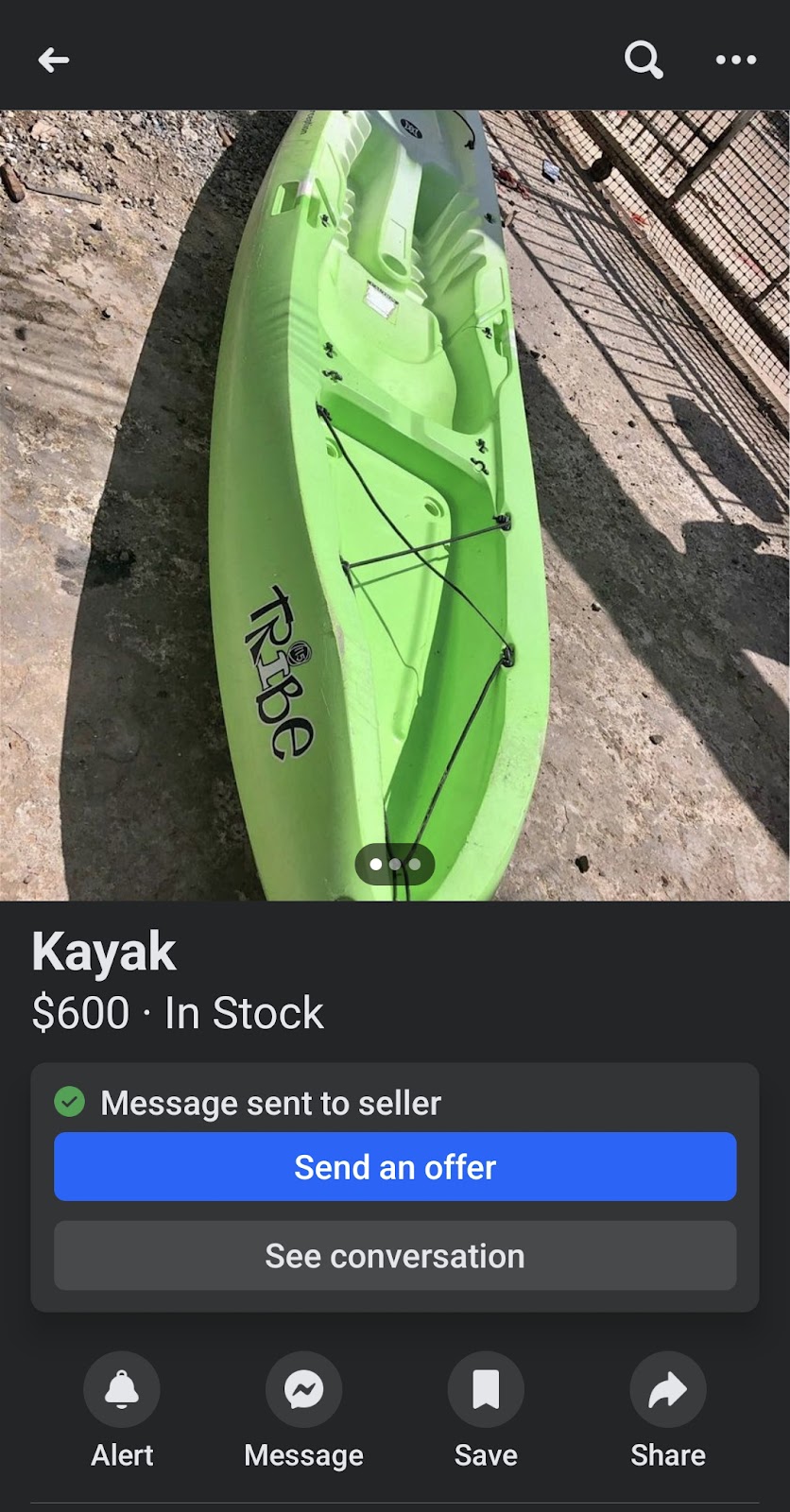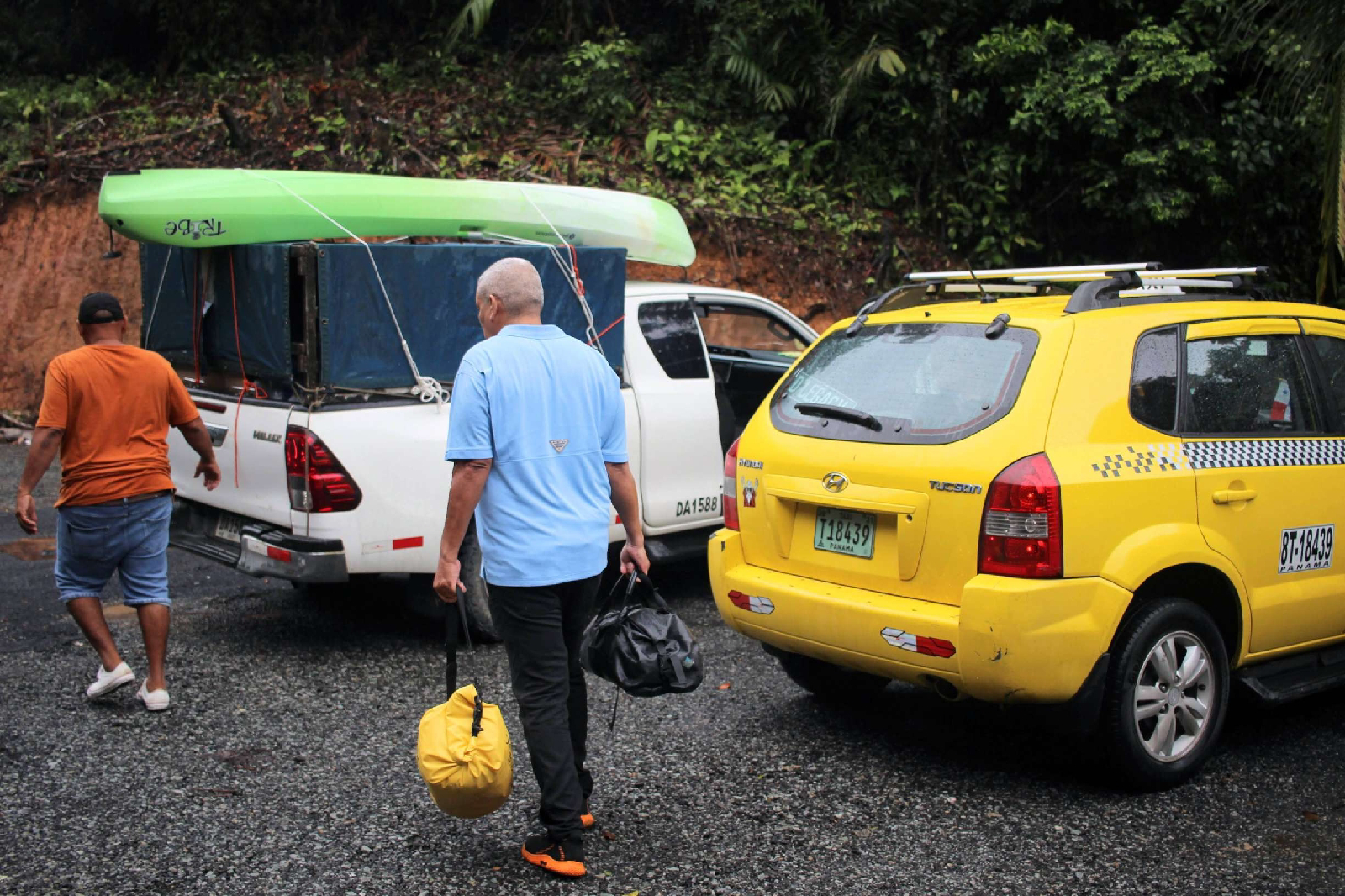Sidequest - Kayaking to Colombia - Part 1
I'm bicycle touring from Oregon, USA towards Argentina. In September and August 2023 I shipped my bicycle from Panama to Colombia, and got around the Darien Gap in a kayak.
This is an account of my planning process, personal experience, and advice. I aim to provide useful information to others who wish to make a similar trip. I also plan on contributing to Getting Around the Darien Gap by Boat - A Complete Guide, by Cameron Williams.
See Part 2 for a day-by-day trip report and pictures.
Please contact me or leave a comment with questions, corrections, comments, suggestions.
Other trip reports of this crossing:
Iohan (RIP)
Nick and Cary (Nick's post)
Nick and Cary (Cary's post)
-
-
-
Planning this trip, I encountered lots of unknowns. The unknown is, justifiably, scary. And I was scared. Chiefly, I was scared of dying.
I'll organize this report around the very realistic goal of not dying. That said, I don't want to portray this journey as purely a survival-game. See the day-by-day report for a different perspective.
Life-threatening dangers
Drowning
Trauma from being smashed into rocks or coral by rough seas
Swept out to sea by bad weather
Skin cancer
Starvation
Dehydration
Murdered, or robbed of critical supplies/equipment
Sharks
Compromised judgement due to ego, excessive determination, or discomfort
Mosquito-borne illness
Non-life-threatening obstacles
Annoying insects
Overuse injury (blisters, chafing, back/shoulder problems)
Exposure to elements (I think the ocean temperatures makes death from hypo/hyperthermia unlikely)
Logistics
Trouble from authority/bureaucracy/red-tape
Note: I think it's prudent to be a bit guarded about the extent of your plans. Because it's an uncommon undertaking, and because of the reputation of the nearby Darien Gap, people may be alarmed and make your life more difficult if they realize what you're doing. On the other hand, they may be extra supportive...
Necessary Skills
- Physical and mental endurance. A tropical paradise can be a harsh environment.
12 hours of equatorial sun with water reflection, no shade, 30°C or more, humid, sandy, salty, windy, biting insects
50-150 hours of kayaking
Bike touring in Central America is good physical and mental preparation
Basic spanish language skills
I don't think prior kayak touring experience is necessary. I recommend having used a kayak or canoe at least a few times in your life before, though.
With a kayak, especially a closed-cockpit one, you should probably practice 'bracing' (using the paddle to prevent capsize) before you need it.
Internet
With Tigo I received coverage most of the time. At least every 50km. In Carpuganá I got a plan with Claro and received similar coverage.
Encounters with criminals
No locals I spoke with said anything to suggest that this was a risk. Similar to bike touring, I avoided night travel, and tried to camp discreetly.
Illegal migration is a high-volume business, and robbing a foreigner in a kayak is not part of it. It would be like a long-haul-trucker stopping at a free-box.
To illustrate this: In Capurganá, Colombia I watched boats full of 30+ migrants, multiple times throughout the afternoon, arriving at the main port of Capurganá and being unloaded and directed where to go by teams of people in color coded uniforms. I spoke with several groups who were waiting in for the next to take them to the start point of the Darien Gap hiking segment. The hike starts on the Colombian side, where they trek inland and across the boarder to reach the Panamanian road system. On the Panamanian coastline, I saw no evidence of migrant traffic.
Perhaps there are small-time criminals operating along this coastline also, who target small watercraft such as mine. I felt no reason to be seriously concerned about this.
Sharks
Several locals asked me if I was concerned about sharks. I was not. After meeting a man who was missing a piece of arm due to a shark bite, I was more concerned about sharks, but not enough to stop me from getting out of the boat to poop in the ocean. I imagine the risk of shark attack is statistically low, but I can't provide advice beyond limiting your time in the water.
Mosquitoe-borne illness
The mosquitos in this region may carry dengue fever/malaria. This is true of other parts of Panama and Colombia, where many tourists go. Of course you avoid them regardless. If you got very sick, evacuation would be feasible, although it may take some days. Yellow fever vaccination is recommended for travel in this region.
Distance and resupply
This is an inhabited coastline with communities usually every 10-30 km (never more than 40-50 km). I am confident you would be able to acquire food and fresh water at most of these communities
The currency is the US dollar
Depending on the boat/conditions/user I estimate 1.5-6 km/hour.
Even a very slow boat could go fast enough and easily carry enough supplies to reach the next resupply point.
I recommend carrying a significant excess of food, and especially fresh water, so you can comfortably wait-out dangerous weather and don't have to stop at every settlement.
Collecting rainwater is possible, but shouldn't be relied upon.
The village where I stayed drank river water. I don't believe it was purified. Prepare to purify fresh water or be willing to take a risk. I used chemical purification.
Total distance 200-400km depending on route
Evacuation options
In case of emergency or trip-ending obstacle, there may be several options for evacuation.
From any of the communities along the coastline, I am confident that you would be able to find a motorboat ride east or west along the coast, back to road systems. This may take several days or more, depending on the size of the settlement and how much you were willing to pay.
Flagging down a boat from an uninhabited shore or island would be a possibility in some areas.
With cell coverage, you could of course make a 911 call in a emergency.
If you used an emergency beacon SOS call, people would likely be capable of helping. I don't know if the call would actually reach local authorities, though.
Navigation and Route
The Panama Sailing Guide is a highly recommended text for boat travel in this area. It is expensive and hard to get, but according to Iohan, it's all you need for navigation. It would probably give lots more useful information, but I didn't get a copy.
Since you are never far from the coastline (unless crossing the Gulf of Urubá), staying oriented and knowing which way to go is easy.
My larger navigation concern was reefs, which could potentially cause dangerous wave breaks, or cause you to run aground. This was a non-issue, as the wave breaks and reefs could easily be spotted from a distance. My sit-on-top kayak required little depth, and if it hit coral, it was light and durable enough that this was not an issue. A heavier or more delicate boat (dug-out canoe or pack raft), would call for extra caution around reefs.
I'd you're interested, free printable nautical charts for part of the coastline are available at https://caltopo.com/map.html. I printed maps but rarely used them. I also had three GPS-capable devices (phone, wahoo, inreach) with critical gpx files loaded. I recommend GPS redundancy. GPS helped me track my progress and find important ports (especially Necoclí).
Start point:
Puerto Cartí: Shorter paddle distance.
Portabelo: Longer paddle, possibly cheaper/easier transportation to start point.
Panama exit stamp in Puerto Obaldía.
Colombia entry stamp in Carpuganá.
End point:
Carpuganá: If you just want to make it to Colombia. You'll have to take a ferry to Necoclí, because Carpuganá has no road access.
Necoclí: Shortest route to Colombian road access.
Requires a long open-water crossing
This is what I did, but I frankly can't recommend it from a risk standpoint: no landfall options for 26km minimum
Turbo: Access Colombian roads without a long open water crossing.
I have heard that Turbo has more security risk than Necoclí
Dangerous weather and sea conditions
This was my biggest safety concern.
Apparently the sea conditions are the worst between November and January. I crossed during August and September.
My approach was this:
Continuously evaluate several questions:
Consider current conditions.
Do I feel safe in the current weather and sea conditions?
How close are the conditions to feeling unsafe?
What does the weather forecast say?
How does it compare to current conditions?
Swell, wave, wind, rain, ocean current, thunder storm.
I used the free app Windy, which shows all this information on an animated map. It was sometimes accurate; appreciate this limitation.
How long would it take to safely make landfall from here?
How far am I from shore or island?
What is the wave break like?
Are there reefs in the way?
It's the shore a nice beach or rugged rocks?
If my answers merited it, I would make landfall and wait, with all my extra food and water. I had good weather the whole time and it never came to this.
Boat types
Pack-raft
Pros:
Logistically more simple because the boat can be carried on the bike
Cons:
Requires use of pack-raft
Slower
Can be punctured
Difficult to acquire
Dug-out canoe
Pros:
More space for carrying a bicycle
Logistically more simple because dug-out canoe would be purchased at the port
Badass
Could be very cheap total cost
Cons:
You have to do it in a dug-out canoe
Slow
Incredibly heavy
Possibly a steep learning curve
Would be difficult to sell any further southeast than Carpuganá, because dug-out canoes are mostly used by the Guys Yala tribe of Panama not in Colombia.
Acquiring a dug-out canoe at Puerto Cartí may take some time
Modern hard-shell boats
A modern boat would be purchased in Panama City or Colón. If budget allows, buying a new boat would let you get exactly the right kind. The seller may be willing to assist with transportation.
Single person sea touring kayak
Pros:
The 'right tool for the job'
Fast
Cons:
One should probably be confident in kayak skills such as bracing, and perhaps rolling, too
Can't easily get in and out in deep water
Probably no space for a bicycle
Two person sea touring kayak used by one person
Pros:
Space for a bicycle
Cons:
Slower and harder to control than single person kayak
Sit-on-top kayak
Pros:
Easy to get in and out of in deep water
More stable
Can sleep in it comfortably
Cons:
Slower than closed cockpit designs
Legs exposed to the elements
Initially I tried to find a sea kayak. I couldn't, so I settled for a sit-on-top. I actually think this was better than the sea kayak would have been. The stability, ease of getting in and out, and ability to sleep in the kayak proved very valuable.
If you buy a used kayak, you probably won't have many to choose from unless you're willing to wait in Panama City for a while. (BTW Panama City sucks for biking).
Sourcing a boat
Pack raft
Possibly available by special order from a local kayak store
International shipping to Panama should be avoided
Dug-out canoe
Get to Puerto Cartí and start asking people
Expect to pay 50-300 USD (one person quoted me 200 USD)
Probably not available in Portabelo or Colón, because the dug-out canoes are used by the Guna Yala tribe, and these ports are not Guna Yala territory.
New boat
Find a kayak store on Google maps
The Discovery Center sells very cheap, new kayaks. Perhaps of questionable quality
Used boat
I reached out to several guide companies and kayak stores to see if they had used boats for sale. None of them were selling used boats. It may be worth asking, though.
Facebook marketplace
Additional equipment advice
Cycling gloves for reducing blisters.
Leg sun protection (unless in a closed cockpit kayak). I bought white, XXL cycling arm sleeves and used them on my legs. This was perfect.
Buff and wide sunhat for sun and reflection
Boat repair equipment if applicable
Spray skirt and pump to bail closed-cockpit kayaks
Rope
Waterproof plastic sleeves for maps, gps, phone, passport
Drybags
PFD
Consider an extra paddle
Ziploc-type bags
Extra USD
Orchestrating the Logistics
It's hard to carry the bike on the boat, and impossible to carry the boat on the bike (except for a pack-raft). This makes the logistics kind of tricky.
I highly recommend getting in contact with the Panama Overland Embassy. They assist overlanders (mostly motor vehicles) with logistics: vehicle storage, service and maintenance, shipping, and camping. They can probably help you ship the bicycle to Colombia, too. They are flexible and eager to help with whatever. They speak English.
There are so many different ways to sequence things, I won't recommend a specific plan. Here is roughly what I did, to give you an idea:
Arrived in Panama City by bicycle
Bought food (90 USD) and special equipment (100 USD) by bicycle
Camped at Panama Overland Embassy (5 USD/night)
Kayak seller dropped off kayak at Panama Overland Embassy campground (I paid 350 USD for the kayak)
Panama Overland Embassy helped me ship my bicycle
They gave me the contact information of a couple who was shipping their van from Panama to Cartagena, Colombia
When I departed Panama City with the kayak, I left the bicycle at Panama Overland Embassy
A week later, the couple with the van arrived in Panama City and put my bike in their van
The van was shipped to Cartagena
I paid them 150 USD for this. I could have offered less, but they were doing me a big favor
I expected to reach Cartagena before the van, so I planned to wait there for my bicycle. As a contingency, I also arranged for the bicycle to be dropped off with a Warm Showers host who was willing to store my bicycle
Scheduled a taxi with room for a kayak to Puerto Cartí
I paid 90 USD. Two other taxi companies quoted me 250 USD and 320 USD
Uber XL could be a good option.
There is a checkpoint on the road to Puerto Cartí where foreigners must pay 20 USD. At the checkpoint, they did not allow the taxi to pass, because the taxi driver didn't have a reservation. A local was willing to transport me and the kayak the rest of the way to Cartí for 25 USD. This could possibly be mitigated by informing the taxi driver that they might need a reservation to pass.
At Cartí I was told there was a rule which forbid me from leaving the port by kayak. I found a ride to an island several kilometers offshore (10 USD), from which I was permitted to depart by kayak. This could arguably prevent a 100% human powered crossing.
Kayaked to Necoclí, with mandatory stops in Puerto Obaldía and Carpuganá for passport stamps.
Slept on the beach in Necoclí for one night and sold the kayak the next day. (By word of mouth)
Bussed to Cartagena (25 USD) and waited for the bicycle to arrive.
Other ways you may be able to ship a bicycle:
Word of mouth at a port
By air with a shipping company
I was told I must be present on it's day of arrival, and gave up on this
With a tour company such as Wildcard Sailing which does catered trips from Panama to Colombia. I never received a response from them.
Is this legal?
Trouble with authority figures depends on the specifics of the interaction with them, regardless of the letter of the law. Courtesy and language skills can go a long way. After reading the report from Nick and Cary's crossing of being sent back to the start location, I was very cautious about admitting my intentions, especially near the beginning of the trip.
For example, at Puerto Cartí, they called their boss to ask if I was allowed to leave the port by kayak, and I was not allowed to. If I had told them my real plans, it would have made my life more difficult. I told them that I planned to camp on some nearby islands for tourism and I avoided giving more information. 3/4 of the way to the border, I was stopped by police. I showed my passport and told them my full intentions, because I was already most of the way there.
Where to camp?
Uninhabited islands are plentiful in San Blas, roughly the first 50km east of Puerto Cartí. Some islands are resorts where payment is required even just to tent-camp.
The coastline appeared to be viable for camping the whole way, although it got progressively more rocky and rough from Cartí to Carpuganá.
Asking to camp at or near a village would be a good option. They will likely say yes, and quite possibly invite you in. There are also probably fewer biting midges.
The biting midges/no-see-ums were difficult to deal with. The small ones were able to pass freely through the mesh in my MSR tent, and they are highly resistant to DEET. This resulted in two nearly sleepless nights, and motivated me to try sleeping on the kayak.
Sleeping in my sit-on-top kayak was surprisingly comfortable. I used a big rock as an anchor and carefully chose a protected location, safe from wave breaks, with access to a beach, where motorboats would not hit me. If the weather worsened during the night, I assumed it would wake me up, and I could move into shore. This didn't happen.
Night 1: Coastline
Night 2: Uninhabited island
Night 3: Invited into local village
Night 4: Coastline
Night 5: Coastline
Night 6: In the kayak, 100m from shore
Night 7: In the kayak, 100m from shore (at Puerto Obaldía)
Night 8: On the shore (Playa Soledad, where they film the TV show Survivor)
Night 9: Invited in to a house on the shore (Near Triganá, Colombia)
Night 10: On the beach in Necoclí
Tether to boat
I was scared of somehow being separated from the boat. For example if I were to fall out and the wind pushed the boat faster than I could swim. This would be very bad. So I always clipped a rope tether to my PFD. I don't know whether this is something experienced sea kayaks do, but I thought it was a good idea. Only relevant if traveling alone.
I always tied up the boat twice while camped on an island or shore.
Conclusion
Most cyclists crossing from Panama to Colombia take an airplane. If you're looking for a slower, harder, less comfortable, riskier way to cross that might be more expensive also, I would recommend crossing by human powered seacraft.
It was worth all the trouble.




















So love your humor.
ReplyDelete-Jami
ReplyDelete